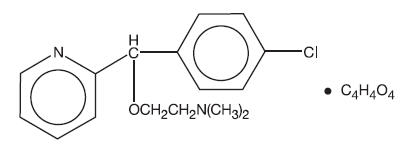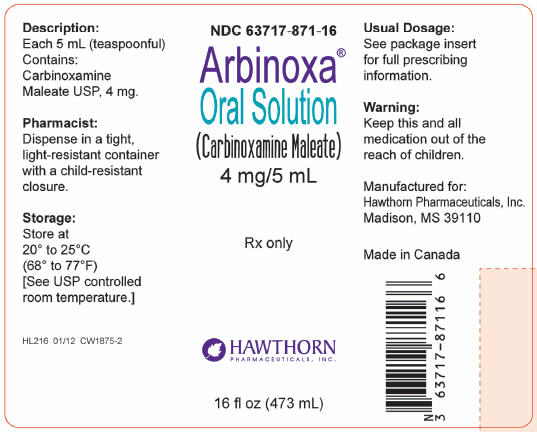ARBINOXA- carbinoxamine maleate solution
Hawthorn Pharmaceuticals, Inc.
----------
Arbinoxa® (Carbinoxamine Maleate) Oral Solution
[Hawthorn Pharmaceuticals, Inc]
Rx only
DESCRIPTION
Carbinoxamine maleate is a histamine-H1 receptor blocking agent.
Each 5 mL (teaspoonful) of oral solution contains 4 mg carbinoxamine maleate and the following inactive ingredients: artificial bubble gum flavor, citric acid (anhydrous), glycerin, methylparaben, propylene glycol, propylparaben, purified water, sodium citrate (hydrous) and sorbitol solution.
Carbinoxamine maleate is freely soluble in water. Its structure is:

2-[(4-chlorophenyl)-2-pyridinylmethoxy]-N, N-dimethylethanamine (Z)-2-butenedioate (1:1)
C16H19ClN2O•C4H4O4
MW = 406.86
CLINICAL PHARMACOLOGY
Carbinoxamine maleate is an antihistamine with anticholinergic (drying) and sedative properties. Antihistamines appear to compete with histamine for receptor sites on effector cells.
The pharmacological effects of carbinoxamine maleate after oral absorption have been shown to last approximately 4 hours.
Interactions of carbinoxamine maleate with food or with other drugs and the possibility of cardiac conduction effects on the QT interval have not been studied.
INDICATIONS AND USAGE
Carbinoxamine maleate is effective for the symptomatic treatment of:
Seasonal and perennial allergic rhinitis.
Vasomotor rhinitis.
Allergic conjunctivitis due to inhalant allergens and foods.
Mild, uncomplicated allergic skin manifestations of urticaria and angioedema.
Dermatographism.
As therapy for anaphylactic reactions adjunctive to epinephrine and other standard measures after the acute manifestations have been controlled.
Amelioration of the severity of allergic reactions to blood or plasma.
CONTRAINDICATIONS
Carbinoxamine maleate is contraindicated in children younger than 2 years of age.
Carbinoxamine maleate is contraindicated in nursing mothers.
Carbinoxamine maleate is contraindicated in patients who are hypersensitive to the drug or on monoamine oxidase inhibitor therapy. (See Drug Interactions section.)
WARNINGS
Deaths have been reported in children less than 2 years of age who were taking antihistamines, including carbinoxamine-containing drug products, therefore, carbinoxamine maleate is contraindicated in children younger than 2 years of age (see CONTRAINDICATIONS).
Antihistamines should be used with considerable caution in patients with: narrow angle glaucoma, stenosing peptic ulcer, symptomatic prostatic hypertrophy, bladder neck obstruction, pyloroduodenal obstruction.
PRECAUTIONS
General
As with many other antihistamines, carbinoxamine maleate has an atropine-like action and, therefore, should be used with caution in patients with: increased intraocular pressure, hyperthyroidism, cardiovascular disease, hypertension.
Antihistamines such as carbinoxamine maleate should not be used to treat lower respiratory tract symptoms, including asthma.
Information for Patients
Carbinoxamine maleate may cause drowsiness; alcohol, sedatives, and tranquilizers may increase the drowsiness effect. Avoid alcoholic beverages while taking this product. Do not take this product if you are taking sedatives or tranquilizers, without first consulting your doctor. Use caution when driving a motor vehicle or operating machinery.
Drug Interactions
Monoamine oxidase inhibitors prolong and intensify the anticholinergic (drying) effects of antihistamines.
Carbinoxamine maleate has additive effects with alcohol and other CNS depressants (hypnotics, sedatives, tranquilizers, etc.).
Carcinogenesis, Mutagenesis, Impairment of Fertility
No long-term studies in animals have been performed to determine the possible effects of carbinoxamine maleate on carcinogenesis, mutagenesis, and fertility.
Pregnancy
Pregnancy Category C
Animal reproductive studies have not been conducted with carbinoxamine maleate. It is also not known whether carbinoxamine maleate can cause fetal harm when administered to a pregnant woman or can affect reproductive capacity. Carbinoxamine maleate should be given to a pregnant woman only if clearly needed.
Nursing Mothers
Because of the higher risk of antihistamines for infants generally and for newborns and prematures in particular, use of carbinoxamine maleate is contraindicated in nursing mothers (see CONTRAINDICATIONS section).
Pediatric Use
Carbinoxamine maleate is contraindicated in children younger than 2 years of age (see CONTRAINDICATIONS).
Carbinoxamine maleate may diminish mental alertness in children. In the young child, particularly, they may produce excitation.
Geriatric Use
Carbinoxamine maleate is more likely to cause dizziness, sedation, and hypotension in elderly patients (approximately 60 years or older). Sedating drugs may also cause confusion and over sedation in the elderly. Therefore, dose selection for an elderly patient should be cautious, usually starting at the low end of the dosing range, reflecting the greater frequency of decreased hepatic renal, or cardiac function, and of concomitant disease or other drug therapy.
ADVERSE REACTIONS
The most frequent adverse reactions are underlined:
Body as a Whole: Urticaria, drug rash, anaphylactic shock, photosensitivity, excessive perspiration, chills, dryness of mouth, nose and throat.
Cardiovascular: Hypotension, headache, palpitations, tachycardia, extrasystoles.
Hematologic: Hemolytic anemia, thrombocytopenia, agranulocytosis.
Central Nervous System: Sedation, sleepiness, dizziness, disturbed coordination, fatigue, confusion, restlessness, excitation, nervousness, tremor, irritability, insomnia, euphoria, paresthesia, blurred vision, diplopia, vertigo, tinnitus, acute labyrinthitis, hysteria, neuritis, convulsions.
Gastrointestinal: Epigastric distress, anorexia, nausea, vomiting, diarrhea, constipation.
Urogenital: Urinary frequency, difficult urination, urinary retention, early menses.
Respiratory: Thickenings of bronchial secretions, tightness of chest and wheezing, nasal stuffiness.
OVERDOSAGE
Manifestations
Antihistamine over dosage reactions may vary from central nervous system depression to stimulation. Stimulation is particularly likely in children. Atropine-like signs and symptoms – dry mouth; fixed, dilated pupils; flushing; and gastrointestinal symptoms may also occur.
Especially in infants and children, antihistamine overdosage may cause hallucinations, convulsions, or death.
The oral LD50 of carbinoxamine maleate in guinea pigs is 411 mg/kg.
Treatment
The treatment of overdosage with carbinoxamine maleate is essentially symptomatic and supportive. Vital signs (including respiration, pulse, blood pressure, and temperature) and EKG should be monitored. Induction of vomiting is not recommended. Activated charcoal should be given and gastric lavage should be considered after ingestion of a potentially life-threatening amount of drug. In the presence of severe anticholinergic effects, physostigmine may be useful. Vasopressors may be used to treat hypotension.
DOSAGE AND ADMINISTRATION
Carbinoxamine maleate is contraindicated in children younger than 2 years of age (see CONTRAINDICATIONS).
Carbinoxamine maleate should be taken on an empty stomach with water.
DOSAGE SHOULD BE INDIVIDUALIZED ACCORDING TO THE NEEDS AND THE RESPONSE OF THE PATIENT.
Carbinoxamine maleate dosage should be based on the severity of the condition and the response of the patient. The drug is well tolerated in doses as high as 24 mg daily, in divided doses, over prolonged periods. On the other hand, some patients respond to as little as 4 mg daily.
Clinical experience suggests the following dosage schedules:
Oral Solution:
Usual Adult Dosage:
1 or 2 teaspoonfuls (4 to 8 mg)
3 to 4 times daily
Usual Child's Dosage (approximately 0.2 – 0.4 mg/kg/day divided into 3 to 4 doses):
Six to eleven years – ½ to 1 teaspoonful (2 to 4 mg) 3 to 4 times daily.
Dosing for children 2 to 5 years of age should be based on weight whenever possible. The usual dosage for children 2 to 5 years of age is approximately 0.2 to 0.4 mg/kg/day, divided into 3 to 4 daily doses. In general, this corresponds to a dose of ¼ to ½ teaspoonful (1 to 2 mg) 3 to 4 times daily.
HOW SUPPLIED
Arbinoxa® (Carbinoxamine Maleate) Oral Solution, 4 mg/5 mL is supplied as clear, colorless liquid with a bubble gum aroma, and is supplied in 16 oz bottles NDC 63717-871-16.
Store at 20° to 25°C (68° to 77°F) [See USP controlled room temperature.]
Dispense in a tight, light-resistant container with a child-resistant closure as defined in the official compendium.
PRINCIPAL DISPLAY PANEL - Bottle Label

Bottle Label
NDC 63717-871-16
Arbinoxa®
Oral Solution
(Carbinoxamine Maleate)
4 mg/5 mL
Rx only
Hawthorn
Pharmaceuticals, Inc.
16 fl oz (473 mL)
Description:
Each 5 mL (teaspoonful)
Contains:
Carbinoxamine
Maleate USP, 4 mg.
Pharmacist:
Dispense in a tight,
light-resistant container
with a child-resistant
closure.
Storage:
Store at
20° to 25°C
(68° to 77°F)
[See USP controlled
room temperature.]
HL216 01/12 CW1875-2
Usual Dosage:
See package insert
for full prescribing
information.
Warning:
Keep this and all
medication out of the
reach of children.
Manufactured for:
Hawthorn Pharmaceuticals, Inc.
Madison, MS 39110
Made in Canada
| ARBINOXA
carbinoxamine maleate solution |
||||||||||||||||||||
|
||||||||||||||||||||
|
||||||||||||||||||||
|
||||||||||||||||||||
|
||||||||||||||||||||
|
||||||||||||||||||||
| Labeler - Hawthorn Pharmaceuticals, Inc. (118049704) |
| Registrant - Hawthorn Pharmaceuticals, Inc. (118049704) |